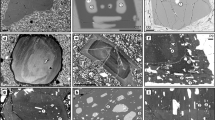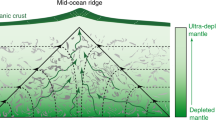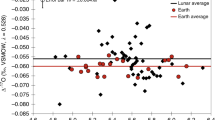Abstract
Immediately following the formation of the Solar System, small planetary bodies accreted1, some of which melted to produce igneous rocks2,3. Over a longer timescale (15–33 Myr), the inner planets grew by incorporation of these smaller objects4,5 through collisions. Processes operating on such asteroids strongly influenced the final composition of these planets4, including Earth5. Currently there is little agreement about the nature of asteroidal igneous activity: proposals range from small-scale melting, to near total fusion and the formation of deep magma oceans2. Here we report a study of oxygen isotopes in two basaltic meteorite suites, the HEDs (howardites, eucrites and diogenites, which are thought to sample the asteroid 4 Vesta6) and the angrites (from an unidentified asteroidal source). Our results demonstrate that these meteorite suites formed during early, global-scale melting (≥ 50 per cent) events. We show that magma oceans were present on all the differentiated Solar System bodies so far sampled. Magma oceans produced compositionally layered planetesimals; the modification of such bodies before incorporation into larger objects can explain some anomalous planetary features, such as Earth's high Mg/Si ratio.
This is a preview of subscription content, access via your institution
Access options
Subscribe to this journal
Receive 51 print issues and online access
$199.00 per year
only $3.90 per issue
Buy this article
- Purchase on Springer Link
- Instant access to full article PDF
Prices may be subject to local taxes which are calculated during checkout


Similar content being viewed by others
References
Lugmair, G. W. & Shukloyukov, A. Early solar system events and timescales. Meteorit. Planet. Sci. 36, 1017–1026 (2001)
Mittlefehldt, D. W., McCoy, T. J., Goodrich, C. A. & Kracher, A. in Planetary Materials (ed. Papike, J. J.) Ch. 4 (Mineralogical Society of America, Washington DC, 1998)
Nyquist, L. E., Reese, Y., Wiesmann, H., Shih, C.-Y. & Takeda, H. Fossil 26Al and 53Mn in the Asuka 881394 eucrite: evidence of the earliest crust on asteroid 4 Vesta. Earth Planet. Sci. Lett. 214, 11–25 (2003)
Kleine, T., Mezger, K., Mümker, C., Palme, H. & Bischoff, A. 182Hf-182W isotope systematics of chondrites, eucrites, and martian meteorites: Chronology of core formation and early mantle differentiation in Vesta and Mars. Geochim. Cosmochim. Acta 68, 2935–2946 (2004)
Halliday, A. N. Mixing, volatile loss and compositional change during impact-driven accretion of the Earth. Nature 427, 505–509 (2004)
Drake, M. J. The eucrite/Vesta story. Meteorit. Planet. Sci. 36, 501–513 (2001)
Clayton, R. N. & Mayeda, T. K. Oxygen isotope studies of achondrites. Geochim. Cosmochim. Acta 60, 1999–2017 (1996)
Buchanan, P. C., Zolensky, M. E. & Reid, A. M. Carbonaceous chondrite clasts in the howardites Bholghati and EET87513. Meteoritics 28, 659–669 (1993)
Metzler, K., Bobe, K. D., Palme, H., Spettel, B. & Stöffler, D. Thermal and impact metamorphism on the HED parent asteroid. Planet. Space Sci. 43, 499–525 (1995)
Mason, B. Meteorites (Wiley, New York, 1962)
Stolper, E. Experimental petrology of eucrite meteorites. Geochim. Cosmochim. Acta 41, 587–611 (1977)
Righter, K. & Drake, M. J. A magma ocean on Vesta: Core formation and petrogenesis of eucrites and diogenites. Meteorit. Planet. Sci. 32, 929–944 (1997)
Boesenberg, J. S. & Delaney, J. S. A model composition of the basaltic achondrite planetoid. Geochim. Cosmochim. Acta 61, 3205–3225 (1997)
Agnor, C. & Asphaug, E. Accretion efficiency during planetary collisions. Astrophys. J. 613, L157–L160 (2004)
Nolan, M. C., Asphaug, E., Greenberg, R. & Melosh, H. J. Impacts on asteroids: Fragmentation, regolith transport, and disruption. Icarus 153, 1–15 (2001)
Amelin, Y., Krot, A. N., Hutcheon, I. D. & Ulyanov, A. A. Lead isotopic ages of chondrules and calcium-aluminum-rich inclusions. Science 297, 1678–1683 (2002)
Reddy, K. P. R., Oh, S. M., Major, L. D. Jr & Cooper, A. R. Oxygen diffusion in fosterite. J. Geophys. Res. 85, 322–326 (1980)
Valley, J. W. Stable isotope thermometry at high temperatures. Rev. Mineral. Geochem. 43, 365–402 (2001)
Taylor, G. J. Core formation in asteroids. J. Geophys. Res. 97, 717–726 (1992)
Glavin, D. P., Kubny, A., Jagoutz, E. & Lugmair, G. W. Mn-Cr isotope systematics of the D'Orbigny angrite. Meteorit. Planet. Sci. 39, 693–700 (2004)
Jurewicz, A. J. G., Mittlefehldt, D. W. & Jones, J. H. Experimental partial melting of the Allende (CV) and Murchison (CM) chondrites and the origin of asteroidal basalt. Geochim. Cosmochim. Acta 57, 2123–2139 (1993)
McCoy, T. J., Keil, K., Muenow, D. W. & Wilson, L. Partial melting and melt migration in the acapulcoite-lodranite parent body. Geochim. Cosmochim. Acta 61, 639–650 (1997)
Guan, Y. & Crozaz, G. Microdistributions and petrogenetic implications of rare earth elements in polymict ureilites. Meteorit. Planet. Sci. 36, 1039–1056 (2001)
Drake, M. J. & Righter, K. Determining the composition of the Earth. Nature 416, 39–61 (2002)
Rubie, D. C., Gessman, C. K. & Frost, D. J. Partitioning of oxygen during core formation on Earth and Mars. Nature 429, 58–61 (2004)
Mittlefehldt, D. W. & Lindstrom, M. M. Geochemistry of eucrites: Genesis of basaltic eucrites and Hf and Ta as petrogenetic indicators for altered Antarctic eucrites. Geochim. Cosmochim. Acta 67, 1911–1935 (2003)
Telesco, C. M. et al. Mid-infrared images of β Pictoris and the possible role of planetesimal collisions in the central disk. Nature 433, 133–136 (2005)
Miller, M. F., Franchi, I. A., Sexton, A. S. & Pillinger, C. T. High precision Δ17O measurements of oxygen from silicates and other oxides: method and applications. Rapid Commun. Mass Spectrom. 13, 1211–1217 (1999)
Wiechert, U. H., Halliday, A. N., Palme, H. & Rumble, D. Oxygen isotope evidence for rapid mixing of the HED meteorite parent body. Earth Planet. Sci. Lett. 221, 373–382 (2004)
Franchi, I. A., Wright, I. P., Sexton, A. S. & Pillinger, C. T. The oxygen-isotopic composition of Earth and Mars. Meteorit. Planet. Sci. 34, 657–661 (1999)
Acknowledgements
We thank M. Drake for comments on the manuscript.
Author information
Authors and Affiliations
Corresponding author
Ethics declarations
Competing interests
Reprints and permissions information is available at npg.nature.com/reprintsandpermissions. The authors declare no competing financial interests.
Supplementary information
Supplementary Table
Oxygen isotope data for HEDs and angrites. (XLS 28 kb)
Supplementary Notes
Model to study a partial melting of a non-equilibrated HED parent body. (XLS 37 kb)
Supplementary Methods
Oxygen isotope analysis using an infrared laser fluorination system. (DOC 26 kb)
Supplementary Discussion
Differences between magma oceans on asteroids and planets and additional references. (DOC 24 kb)
Rights and permissions
About this article
Cite this article
Greenwood, R., Franchi, I., Jambon, A. et al. Widespread magma oceans on asteroidal bodies in the early Solar System. Nature 435, 916–918 (2005). https://doi.org/10.1038/nature03612
Received:
Accepted:
Issue Date:
DOI: https://doi.org/10.1038/nature03612
This article is cited by
-
Impact mixing among rocky planetesimals in the early Solar System from angrite oxygen isotopes
Nature Astronomy (2023)
-
Igneous meteorites suggest Aluminium-26 heterogeneity in the early Solar Nebula
Nature Communications (2023)
-
The Geochemical Legacy of Low-Temperature, Percolation-Driven Core Formation in Planetesimals
Earth, Moon, and Planets (2023)
-
Potassium isotope heterogeneity in the early Solar System controlled by extensive evaporation and partial recondensation
Nature Communications (2022)
-
Olivine-rich achondrites from Vesta and the missing mantle problem
Nature Communications (2021)
Comments
By submitting a comment you agree to abide by our Terms and Community Guidelines. If you find something abusive or that does not comply with our terms or guidelines please flag it as inappropriate.



